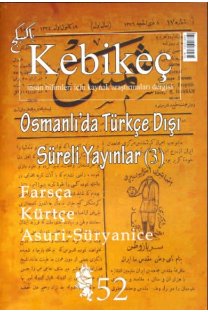Anadolu Bozkırları ve Bozkırların Kuşları
___
Alonso J. C., Belik V., Boutin J., Cheylan G., Dixon J., Farago S., Galushin V., Kollar H. P.,Martinez C., Angel Naveso J., Suarez F., Voisin S. 1997. "Steppic habitats". Tucker G. M.
ve Evans M. I. (ed). Habitats for birds in Europe: a conservation strategy for wider environment. BirdLife International (BirdLife Conservation Series no. 6). Cambridge, UK, ss. 267-325.
Alonso J.C., Palacín C. 2010. "The world status and population trends of the great bustard (Otis tarda): 2010 update". Chinese Birds 1(2): 141-147.
Andrewartha H. G. ve Birch L. C. 1954. The distribution and abundance of animals. The University of Chicago Press, Chicago, Illinois, USA.
Barbanera F., Negro J. J., Di Giuseppe G., Bertoncini F., Capelli F., Dinni, F. 2008. Analysis of the genetic structure of red-legged partridge (Alectoris rufa, Galliformes) populations by means of mitochondrial DNA and RAPD markers: a study from Central Italy Biological Conservation, 122 (2005): 275-287.
Beaman M. 1978. Bird report 1974-1975. The Ornithological Society of Turkey, UK. Bilgin C ve Akçakaya R. 1990. "Kuşlar". Türkiye'nin biyolojik zenginlikleri, ed. A. Kence, Türkiye Çevre Sorunları Vakfı Yayınları, Ankara, s. 183-202.
BirdLife International 2014. IUCN Red List for birds. http://www.birdlife.org Bozdogan M., Balkiz O., Tavares J. 2007. Survey of social lapwing (Vanellus gregarius) in southeastern Anatolia during early Spring 2007. Doğa Derneği, Ankara.
Brook B. W., Sodhi N. S., Bradshaw C. J. A. 2008. "Synergies among extinction drivers under global change". Trends in Ecology and Evolution 23: 453-460.
Ergene S. 1945. Türkiye Kuşları, İstanbul Üniversitesi Fen Fakültesi Monografileri, Sayı 4, İstanbul.
Ferrero M. E., Blanco-Aguiar J. A., Lougheed S. C., Sánchez-Barbudo I., de Nova P. J. G.
2011 "Phylogeography and genetic structure of the red-legged partridge (Alectoris rufa): more evidence for refugia within the Iberian glacial refugium". Molecular Ecology 20: 2628.2642.
Githaiga-Mwicigi J. M. W., Fairbanks D. H. ve Midgley G. 2002. "Hierarchical processes define spatial pattern of avian assemblages restricted and endemic to the arid Karoo, South Africa". Journal of Biogeography 29: 1067-1087.
Goriup P.D. 1988. Ecology and conservation of grassland birds. International Conservation of Bird Preservation (Tech. Publ. 7), Cambridge, UK.
Jetz W., Wilcove D. S. ve Dobson , A. P. 2007. "Projected impacts of climate and land-use change on the global diversity of birds". PLoS Biology 5(6): e157
Julliard R., Jiguet F. ve Couvet D. 2003. "Common birds facing global changes: what makes a species at risk?" Global Change Biology 10: 148-154.
Kasparek M. 1992. Die Vögel der Turkei. Eine Übersicht, Max Kasparek Verlag, Heidelberg, Germany.
Kasparek M. ve Bilgin C. 1996. "Türkiye kuşları tür listesi". Türkiye Omurgalıları Tür Listesi (ed. A. Kence ve C. Bilgin). PT/TÜBiTAK, Ankara, s. 25-88.
Kasparyan A. 1956. "A preliminary systematic list of birds of Turkey". İstanbul Üniversitesi Fen Fakültesi Mecmuası. 21: 27-48.
Kılıç D. T. ve Eken G. 2004. Türkiye'nin Önemli Kuş Alanları-2004 Güncellemesi. Doğa Derneği, Ankara, Türkiye.
Kirwan G. M., Martins R. P., Eken G. ve Davidson P. 1998. A Checklist of the Birds of Turkey. Sandgrouse. Supplement 1: 1-29.
Kirwan G. M., Boyla K., Castell P., Demirci B., Özen M., Welch H. ve Marlow T. 2008. The Birds of Turkey: The Distribution, Taxonomy and Breeding of Turkish Birds. Christopher Helm. London, UK.
Kiziroğlu İ. 1989. Türkiye Kuşları, O.G.M. Basımevi, Ankara
Kumerloeve H. 1961. "Zur kenntnis der avifuna kleinasiens". Bonner Zoologische Beitrage. 12: 1- Kumerloeve H. 1986. "Bibliographie der saugetiere und vögel der Türkei (Rezente Fauna)",
Bonner Zoologisch Monographien, Nr. 21, Bonn, Germany.
Kuşbank 2014. Kuşabank-www.kusbank.org Magnin G., Eken G., Yarar M. 2000. "Turkey". Important Bird Areas in Europe. Priority sites for conservation, Melanie F. Heath ve Michael I. Evans (ed). C. 1-2. Cambridge UK, BirdLife Conservation Series 8.
Mitchell D. 2017. Birds of Europe, North Africa and the Middle East. An Annotated Checklist. Lynx Edicions. Barcelona, Spain.
Pimm S. L. 2008. "Biodiversity: climate change or habitat loss-which will kill more species?" Current Biology. 18: 117-119.
Sheldon R. D., Kamp J., Koshkin M. A., Urazaliev R. S., Iskakov T. K., Field R. H., Salemgareev A. R., Khrokov V. V., Zhuly V. A., Sklyarenko S. L., Donald P. F. 2013. "Breeding ecology of the globally threatened Sociable Lapwing Vanellus gregarius and the demographic drivers of recent declines". Journal of Ornithology 154: 501-516.
Şekercioglu C. H., Schneider S. H., Fay J. P., Loarie S. R. 2008. "Climate change, elevational range shifts, and bird extinctions". Conservation Biology 22: 140-150.
TRAKUŞ 2014. Türkiye'nin Anonim Kuşları-www.trakus.org Tucker G. M. ve Evans M. I. 1997. Habitats for birds in Europe: a conservation strategy for wider environment.
BirdLife International (BirdLife Conservation Series no. 6). Cambridge, UK.
Tucker G. M. ve Dixon J. 1997. "Agricultural and Grassland Habitats". Tucker G. M. ve Evans M. I. (ed). Habitats for birds in Europe: a conservation strategy for wider environment. BirdLife International (BirdLife Conservation Series no. 6), Cambridge, UK, pp. 267-325 Turan, N. 1990. Kuşlar, O.G.M. Basımevi, Ankara.
Vaitkuviene D. ve Dagys M. "Two-fold increase in White Stork (Ciconia ciconia) population in Lithuania: a consequence of changing agriculture?" Turkish Journal of Zoology 38: baskıda.
Welch H. ve Kirwan G. M. 2008. "Turkey's Ecoregions: their Biodiversity and Conservation". Kirwan et al. The Birds of Turkey. Helm Publications, UK. pp. 31-41.
Wolkinger F. ve Plank S. 1981. Dry grasslands of Europe. Strasbourg, France: Council of Europe.
Zink R. M., Pavlova A., Drovetski S., Wink M., Rohwer S. 2009." Taxonomic status and evolutionary history of the Saxicola torquata complex". Molecular Phylogenetics and Evolution 52: 769-773.
- ISSN: 1300-2864
- Yayın Aralığı: Yılda 2 Sayı
- Başlangıç: 1995
- Yayıncı: Mehtap Yüksel
Sayıdaki Diğer Makaleler
Osmanlı Basınında İhtikâr: Temsil, Mizah ve Mağduriyet (1917-18)
Türkçe Çocuk Gazetelerinde Osmanlı Kimliği (1869-1908)
Kore Savaşı ve Bir Dostluk Hikâyesi: Yüzbaşı'nın Kızı Min Ja
Bora AYERDEN, Zeynep DOKUR, Burcu DOYURAN, Melis KIZILDEMİR, Gülce PULAT
1908 Sonrası Dinde Reformun Bir Adımı Olarak Türkçe Hutbe Tartışmaları
Osmanlı Gümrüğünde Bir Geçiş Belgesi: Pasavan veya Geçit Tezkeresi
Küçük Bir Memeli Türünün Ekofizyolojisi ve Evrimsel Coğrafyası: Anadolu Yer Sincabı
"Sol"a Savrulan Dergi Yürüyüş (İstanbul/1941-1943)
Anadolu Diyagonali: Bir Biyocoğrafi Sınırın Anatomisi
İlhanlı Valisi Emir Timurtaş’ın İsyanı
